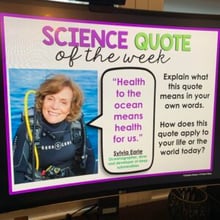Balancing Chemical Equations Activities
for Middle School Science
The resources below will provide students a comprehensive understanding of balancing chemical equations. All of the following lessons are also included in the Kesler Science Membership.
The Balancing Chemical Equations 5E Lesson includes materials for every "E" phase, including the Balancing Chemical Equations Station Lab for Exploration and an interactive PowerPoint with digital INB templates for Explanation.
The lesson also includes introduction materials for Engagement, student-choice project ideas for Elaboration, and assessments for Evaluation.
After completing the Balancing Chemical Equations 5E Lesson, students will be able to recognize whether a chemical equation containing coefficients is balanced or not and how that relates to the law of conservation of mass. They will also be able to determine the difference between reactants and products in a chemical equation.
The Balancing Chemical Equations Inquiry Lab is a hands-on activity that is differentiated for advanced, on-level, and modified middle school students.
Students will be making models with gumdrops and toothpicks.
The Balancing Chemical Equations Inquiry Lab includes a brief reading passage, comprehension checks, hands-on activities, reflection questions, and a CER conclusion.
The Balancing Chemical Equations Sub Plan is a complete lesson that takes students through a warm-up, reading passage, independent activity, extension activities, and an assessment.
The worksheets are designed to make your sub day a breeze for you, your students, and the substitute teacher. They are also perfect for distance learning.
Balancing Chemical Equations Classroom Experiences
Create a powerful student experience to help solidify students' understanding about balancing chemical equations. All of the following experiences are also included in the Kesler Science Membership.
Escape Rooms
The Counting Atoms and Balancing Equations Escape Room is an immersive experience for your students. It allows them to demonstrate their knowledge of counting atoms and determine if an equation is balanced or not.
Students must use what they have learned, including the ability to recognize that chemical formulas are used to identify substances and determine the number of atoms of each element in chemical formulas containing subscripts; to investigate how evidence of chemical reactions indicate that new substances with different properties are formed; and to develop and use a model to describe how the total number of atoms does not change in a chemical reaction and thus mass is conserved to complete the escape room.
Explories - A Complete NGSS Storyline
Explories are NGSS units that integrate a storyline and project-based learning with Kesler Science Inquiry Labs, Station Labs, and 5E Lessons. The Explories unit below is also included in the Kesler Science Membership .

CAUGHT: An NGSS Study of Forensics
Welcome to CAUGHT. This is an NGSS unit that integrates a storyline and projects with existing Kesler Science inquiry labs, station labs, and 5E Lessons. In this unit, students will be sent through a fictitious Forensics Academy to learn chemistry principles and evidence-gathering skills they need to solve a non-violent crime.
"Have you ever watched a crime show and said to yourself, 'I should be an investigator; I could totally solve that!'? Now is your chance to show off your crime-solving skills.
Congratulations! Your class has been accepted into the Forensic Academy!
Through this unit, you will move through levels of training and earn badges as you prove your skills.
Your preparation starts with an introduction to the nervous system and sensory processes. You will then be ready to complete the first project with a focus on the collection and analysis of crime scene evidence.
Next, your coursework will include chemistry lessons that will give you the tools to analyze collected evidence such as lipstick and blood. By the time you are ready to graduate from the Forensics Academy, you will have a complete Rookie Handbook of information.
This handbook will be of utmost importance as you attempt to solve your first case with your field partner. Good Luck Recruits!"
Year-Round Resources
These year-round activities will increase your students' understanding of many middle school science topics. All of these activities are also included in the Kesler Science Membership.
Visual Data & Graphing
You're not alone if your students struggle with understanding graphs, charts, and tables. It's a skill that takes an enormous amount of practice. This resource will help students build a strong foundation in analyzing data and creating their own data visualizations.
Bell Ringers and Warm-Ups
These middle school science bell ringers are an excellent way to engage your students as soon as they walk into your classroom. This comprehensive FULL YEAR resource includes everything you need to start off each science class with an interesting warm-up activity.
Review Board Games
Each game board has been carefully designed to keep students engaged. There are 10 different action spaces on each board and dozens of question cards. All of the actions are related to science concepts and keep the students motivated throughout the game.
Each game is ready to play. Simply print out the board and the cards and let the students enjoy reviewing nine different units.
Essential Questions and Standards
Below are the essential questions and standards associated with the lessons and activities included in the balancing chemical equations unit. This topic is only one of more than 100 middle school science topics included in the Kesler Science Membership.
-
What are the different parts of chemical equations?
-
How can we tell if a chemical equation is balanced or not?
-
How does balancing equations relate to the law of conservation of mass?
-
MS PS1-5 - Develop and use a model to describe how the total number of atoms does not change in a chemical reaction and thus mass is conserved
-
MS LS1-7 - Develop a model to describe how food is rearranged through chemical reactions forming new molecules that support growth and/or release energy as this matter moves through an organism
Kesler Science Membership
Imagine never having to search for another middle school science lesson again. The membership gives you access to ALL of the Kesler Science products in one place (Yes, including everything above).
Say goodbye to long hours of lesson prep.


